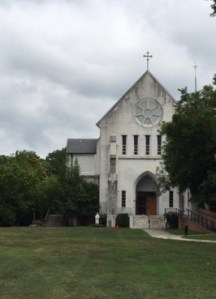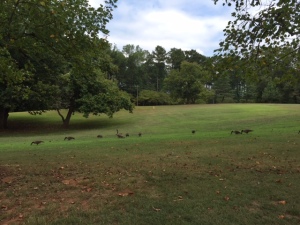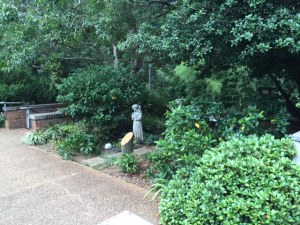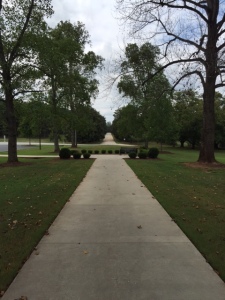Have you ever just wanted to get away from it all? Leave the world behind you and commune with God? Have you needed spiritual clarity? For my birthday this year, I wanted to get away. Yet, I was not drawn so much to my usual birthday pursuits of travel or a spa vacation or the beach. I was yearning for what I did not know at the time was for something more peaceful and serene. I needed to withdraw to a quiet place to nourish my spirit. I was seeking inner guidance and answers to the question of, “What speaks to me now?”
 I went to the Monastery of the Holy Spirit in Conyers, Georgia for a silent spiritual retreat weekend. I have to admit that I was skeptical. This seemed a little odd, kind of airy-fairy. I was going to be with strangers from Friday to Sunday, sleep in a dorm-like room, share meals in silence, and attend prayer services with monks. I was not sure what to expect from the experience. This was a Catholic order. I am not Catholic. The friend who referred me to the Monastery retreat did not say anything about faith being an issue.
I went to the Monastery of the Holy Spirit in Conyers, Georgia for a silent spiritual retreat weekend. I have to admit that I was skeptical. This seemed a little odd, kind of airy-fairy. I was going to be with strangers from Friday to Sunday, sleep in a dorm-like room, share meals in silence, and attend prayer services with monks. I was not sure what to expect from the experience. This was a Catholic order. I am not Catholic. The friend who referred me to the Monastery retreat did not say anything about faith being an issue.
The retreat was about downshifting from daily commotion and listening to that still, small inner voice – not the heckler – but the one in my gut that never steers me wrong. The inner voice can easily be drowned out by noise and busy-ness. I was reminded of the scripture reference, “Be still and know that I am God.” Being still is a spiritual practice that can take the form of any faith. This was not a religious journey or quest. It was about getting quiet enough to hear my inner voice, my intuition, and to receive the clarity and guidance to go forth in a direction that best fits me.
Place of Peace
Throughout the weekend, I felt at peace. The atmosphere was quiet. When people spoke like at the front desk in the lobby or even amongst the friends that were on the retreat together, it was generally soft above a whisper, so as not to disturb others. My to-do list stopped rattling around in my head. I was not constantly checking my cell phone for emails and text messages. It was a low-tech weekend. There was no TV, no radio, no loud talking, not even the sound of passing cars. The pace of everything slowed and became contemplative. I sat on a bench outside and watched moving clouds and admired my toe nail polish.  Instead of rushing from one place to the next, I was mindful of my surroundings. I ate in silence with the other guests. At first, it was strange not to have some conversation. But then, as the weekend progressed, it was actually a relief not to have to come up with a conversation topic. We could enjoy the solitude and be alright. There was nothing wrong. I was particularly moved by this young couple who would wait on one another to arrive at their dining table, and then bow their heads to bless the food in silence. They walked the campus holding hands speechless. Not all couples would be able to spend a weekend living with strangers and not have any conversation at all.
Instead of rushing from one place to the next, I was mindful of my surroundings. I ate in silence with the other guests. At first, it was strange not to have some conversation. But then, as the weekend progressed, it was actually a relief not to have to come up with a conversation topic. We could enjoy the solitude and be alright. There was nothing wrong. I was particularly moved by this young couple who would wait on one another to arrive at their dining table, and then bow their heads to bless the food in silence. They walked the campus holding hands speechless. Not all couples would be able to spend a weekend living with strangers and not have any conversation at all.
The accommodations in the Monastery were basic – two twin beds, one desk, a chair, linen, shared single-sex bathroom and separate shower area. I had an ample size room to myself. Of the 24 weekend participants, there was a 2 to 1 ratio of women to men, and singles to married couples, a sprinkling of racial and ethnic diversity, and the age range varied from young adult college students to Baby Boomers. For most, like me, it was their first time spending the night in a monastery. For a few, they were hooked and had participated in several of the retreats and could attest to the atmosphere of silence to feel renewed and recharged.
The grounds of the Monastery and surrounding buildings consisted of ample trees and sprawling lawns. Even though the Monastery was only thirty minutes outside of Atlanta, the peacefulness made it seem as I was much further away from the city. The Monastic Heritage Center, Historic Museum, Abbey Store, and a bonsai garden are all situated on the Monastery campus.
The church bells rang at 7:00am for the Sunday morning service. The low monotone singing of the Psalms from the monks was a far cry from Gospel music of the Baptist church. One of the monks who lead several prayers had a baritone voice reminiscent of the characterized sound of God commanding Moses at the burning bush in Cecil B. DeMille’s classic “The Ten Commandments.” I sat up straighter on the hard high-back wooden benches and was more attentive with this monk’s prayer.
Cistercian Monks
I did not know much at all about Cistercian monks or their way of life before arriving at the Monastery. Dressed in a religious habit of white robe with a black overlay like a protective apron, the monks represented a brotherhood of discipline, order, and atmosphere of silence. They exuded an inspiring calm and peaceful nature. Monks (of the Cistercian order known as Trappists) are obedient to the call from God and their monastic vows. The original emphasis of the Cistercian monastic life was on simple manual labor and self-sufficiency, with traditional abbeys supporting themselves through agriculture. Today, Cistercian monks spend their lives singing the psalms, leading the sacred scriptures, fasting, praying, serving others, working with their hands in order to give alms sociably and charitably, and living together in a community sincerely seeking God.
Self-Confrontation Workshop
I participated in a scheduled workshop called Self-Confrontation that was an optional part of the retreat weekend. It served as a guide for the interior spiritual work of meditation, prayer, contemplation, and walks on the grounds. The class was team taught by Brother Mark and Jacqueline Rychlicki. During the workshop was the only instance when dialogue was encouraged. The essence of self-confrontation is to slow down and become aware of your own thoughts and behaviors. Bro. Mark stated that the focus on self-confrontation brings up questions for self-reflection:
- How do you deal with what is in front of you?
- What role do you play?
- What you see in others is what is in you.
It would be awesome to say that I came away from the spiritual retreat weekend with definitive answers. Quite the contrary. The Monastery was not some magic formula to vanish my problems. Still, I was reminded of the following spiritual gems:
- Use the tool of silence for the courage to speak the truth, if only to yourself.
- Silence begins from the exterior and moves to the interior by making time and creating space for solitude in order to hear your inner voice and for self-reflection.
- Accept what life brings and come back to the mindfulness of God. To hold no bitterness is to accept all the joy that comes into your life and to accept the sorrow, but cling to none of it.
- People really are mirrors. Whatever you see in me is already in you and invoking your own response. For example, the presence of a monk can bring up feelings of reverence that in fact mirror your own internal wisdom.
- Minimize the amount of criticizing of other people. You are not commissioned to correct everything and everybody in every situation. Of course, this adage is easier said than done.
No matter what is happening around you, you still must find a way to be at peace. That was the lesson for me. I cannot allow the everyday stressors to get to me. Being committed to quiet time is one of the best resources at my control.
When the silent retreat weekend was over, I so wanted to take the serenity and the solitude with me, back into the work world and all the incessant noise and distractions. The Monastery was a safe space, a protected space. The experience left me feeling calm and renewed. I was in a tranquil environment that amplified a sense of well-being and peace – surroundings encouraged prayer and introspection. Absolutely, I would go back for another silent retreat weekend, even without the scheduled workshop. Quiet time must become more of my priority.
For more information on the Monastery of the Holy Spirit, visit www.trappist.net.




